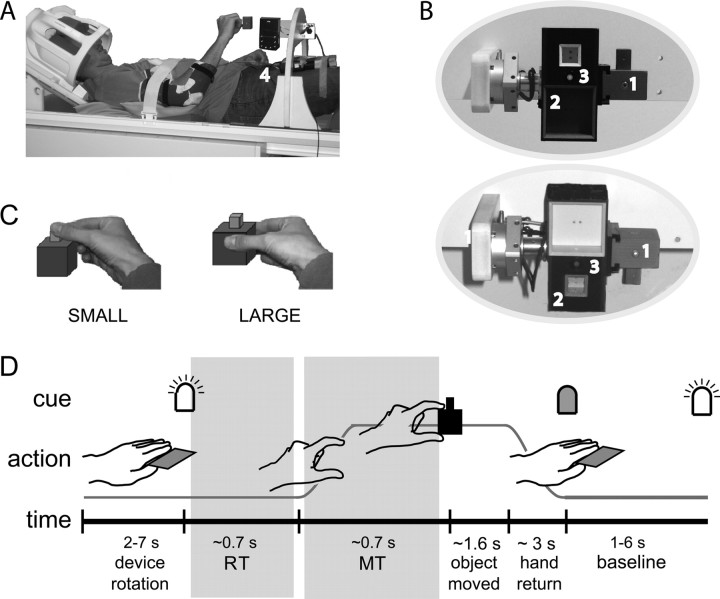Figure 1.
Experimental design. A, Experimental setup. Subjects had to perform visually guided grasping movements and object manipulations while lying supine in the MR scanner. Their head was fitted inside a phased-array receiver head coil. The head coil was tilted forward by 30° along the subject's sagittal plane. This setup allowed the subjects to have a direct line of sight of the objects to be grasped and to visually control their movements. An optical response button box, positioned on the upper leg (4), served as a home key on which subjects had to keep their hand in between trials. This device recorded subjects' reaction and movement times. B, Grasping device. The subjects were instructed to grasp and manipulate an object (1) consisting of a large red cube and a small green cube, attached to a supporting rail positioned in front of them. The object (1) was positioned next to a rectangular box (2) containing two cubic slots. The object was held in place through an arc-shaped device positioned over the subject's hips inside the MR scanner. The subject could comfortably perform visually guided reaching–grasping movements toward the object. An LED (3) instructed the subject on the movement to perform. Whether the small or large object was on top could be varied by means of a pneumatic mechanism. The two ellipses show the subject's direct line of sight in both orientations of the object. C, Task. During the task, subjects grasped the object either at the large (red) or the small (green) part of the object. D, Experimental time course. During the task, in each trial, subjects had to grasp the object either at the large (LARGE) or the small (SMALL) part, remove the object from the rail to put it into one of the two slots, and reposition the object in the supporting rail. When the LED switched on, subjects had to leave the home key as soon as possible, make the appropriate object manipulation, and return to the home key. After 6 s, the LED switched off, and a baseline of variable length (1.5–6 s) followed. Subjects were instructed to complete their action before the LED switched off. At the beginning of each block, the box rotated, followed by a variable amount of time (2–7 s), so that the subject could not predict cue onset. The gray areas refer to the movement planning (RT) and movement execution (MT) phases considered in the DCM.

